History
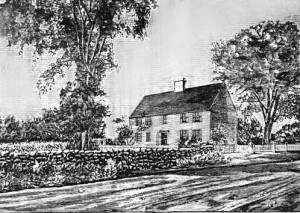 As an insurance agent and living in Wyoming, which does not have the history that some of my ancestors built in the east, when I think of an old house, something in the 1910s comes to mind, but in reality, that is not an old house at all. In fact, by comparison to Bob’s 7th great grandfather, Reverend James Noyes’ house, a home built in 1910 would be considered brand new. The house James Noyes built was, and still is located at 7 Parker Street in Newberry, Massachusetts…a small town of about 7,000 people located in Essex County. It is really a suburb of Newburyport, which has a population of about 18,000. Newbury is situated in the Northeast corner of Massachusetts, near the coast. Newbury was founded by Reverend James Noyes and his cousin Reverend Thomas Parker, who were English clergymen who immigrated to the United States. James Noyes was educated at Oxford, before relocating to Massachusetts in 1634. He spent a short time in Medford, before moving to Newbury to pastor a church there from 1635 until his death. He sailed aboard the Mary and John of London, accompanied by the Hercules on March 23, 1634 with his wife Sarah Noyes, brother Reverend Nicholas Noyes and cousin Reverend Thomas Parker. Newbury was originally named Newbury Plantation, and was incorporated in 1635.
As an insurance agent and living in Wyoming, which does not have the history that some of my ancestors built in the east, when I think of an old house, something in the 1910s comes to mind, but in reality, that is not an old house at all. In fact, by comparison to Bob’s 7th great grandfather, Reverend James Noyes’ house, a home built in 1910 would be considered brand new. The house James Noyes built was, and still is located at 7 Parker Street in Newberry, Massachusetts…a small town of about 7,000 people located in Essex County. It is really a suburb of Newburyport, which has a population of about 18,000. Newbury is situated in the Northeast corner of Massachusetts, near the coast. Newbury was founded by Reverend James Noyes and his cousin Reverend Thomas Parker, who were English clergymen who immigrated to the United States. James Noyes was educated at Oxford, before relocating to Massachusetts in 1634. He spent a short time in Medford, before moving to Newbury to pastor a church there from 1635 until his death. He sailed aboard the Mary and John of London, accompanied by the Hercules on March 23, 1634 with his wife Sarah Noyes, brother Reverend Nicholas Noyes and cousin Reverend Thomas Parker. Newbury was originally named Newbury Plantation, and was incorporated in 1635.

The house that Reverend James Noyes built in 1646, is a historic First Period house, and was added to the National Historic Register of Historic Places in 1990. First Period houses have a steeply pitched roof, a slightly asymmetrical plan, and a central chimney. The first period house is distinguished from later houses by its exposed…often decorated or beveled frame in the interior. Some early windows in modest houses may have had no glazing, but the standard first period window, until at least 1700, was the diamond-paned casement. The main block of the James Noyes house is a 2½ story wood frame structure, five bays wide, with a large central chimney. When the house was first built, it was only a single room deep. Then, around 1800 a 2½ story cross gabled addition was added to the rear, which was further extended by a 1½ story addition later in the 19th century. The interior rooms of the main block have Federal period styling, probably dating to the time of the first addition.
I’m sure that to many people the idea of a house built in 1646 that is still standing is, at best a novelty, but when you couple that with the fact that it was built by one of your ancestors, it becomes a little bit more interesting. My mind wanders back to what life might have been like for them in that home in the mid 1600s.  Of course, there were no modern amenities, such as a bathroom, dishwasher, refrigerator, modern stove, and other such conveniences, but it was still a pretty house for the era, I’m sure. While it was originally quite a bit smaller, but with the additions, it is now 4200 square feet and has six bedrooms. I have looked around online to see if there are any pictures of the interior of the home, but found none to date. Maybe we will have to visit there sometime, but until then, I will just have to be happy knowing that a home built by our ancestor, and a founder of Newbury, Massachusetts is still stand, still in good condition, and still being occupied by a family, who is making memories of their own there.
Of course, there were no modern amenities, such as a bathroom, dishwasher, refrigerator, modern stove, and other such conveniences, but it was still a pretty house for the era, I’m sure. While it was originally quite a bit smaller, but with the additions, it is now 4200 square feet and has six bedrooms. I have looked around online to see if there are any pictures of the interior of the home, but found none to date. Maybe we will have to visit there sometime, but until then, I will just have to be happy knowing that a home built by our ancestor, and a founder of Newbury, Massachusetts is still stand, still in good condition, and still being occupied by a family, who is making memories of their own there.
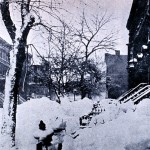 As we sit here, with an early Spring upon us, I find it an odd thing to think about another year that had been rather balmy too. The year was 1888, and things were about to get serious along the northern East Coast. The day began with rain, but as the storm really came at around midnight, the rain turned to snow, and the area began to become a nightmare right before the very eyes of the people in the area. Snowfalls of between 20 to 60 inches were seen in parts of New Jersey, New York, Massachusetts, and Connecticut. The winds howled…sustained winds of more than 45 miles per hour producing snowdrifts in excess of 50 feet. The area railroads were shut down and people were confined to their houses for up to a week. The difficult thing here is that people didn’t have some of the weather predictors that we have these days, so many of them had no idea what was coming their way, and so had far k=less time to prepare for it.
As we sit here, with an early Spring upon us, I find it an odd thing to think about another year that had been rather balmy too. The year was 1888, and things were about to get serious along the northern East Coast. The day began with rain, but as the storm really came at around midnight, the rain turned to snow, and the area began to become a nightmare right before the very eyes of the people in the area. Snowfalls of between 20 to 60 inches were seen in parts of New Jersey, New York, Massachusetts, and Connecticut. The winds howled…sustained winds of more than 45 miles per hour producing snowdrifts in excess of 50 feet. The area railroads were shut down and people were confined to their houses for up to a week. The difficult thing here is that people didn’t have some of the weather predictors that we have these days, so many of them had no idea what was coming their way, and so had far k=less time to prepare for it.
Areas of northern Vermont received from 20 inches to 30 inches in this storm, with drifts reported from 30 to 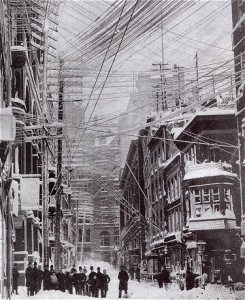 40 feet over the tops of houses from New York to New England. There were also reports of drifts covering 3 story houses. The highest drift…52 feet was recorded in Gravesend, New York. A total of 58 inches of snow fell in Saratoga Springs, New York; 48 inches in Albany, New York; 45 inches of snow in New Haven, Connecticut; and 22 inches of snow in New York City. With the snow came severe winds, with gusts up to 80 miles per hour, although the highest official report in New York City was 40 miles per hour, with a 54 miles per hour gust reported at Block Island. Central Park Observatory, in New York City, reported a low temperature of 6 °F, and a high temperature of 9 °F on March 13…the coldest ever for March. These days Winter Storms have names, but they didn’t then. Nevertheless, the storm was named the Great White Hurricane. It paralyzed the East Coast from the Chesapeake Bay to Maine, as well as the Atlantic provinces of Canada. The Telegraph was disabled because of all the downed lines, isolating Montreal and most of the large northeastern United States cities from Washington DC to Boston for days. Following the storm, New York began placing its telegraph and telephone lines underground to prevent destruction. From Chesapeake Bay through the New England area, more than 200 ships were either grounded or wrecked, killing at least 100 seamen.
40 feet over the tops of houses from New York to New England. There were also reports of drifts covering 3 story houses. The highest drift…52 feet was recorded in Gravesend, New York. A total of 58 inches of snow fell in Saratoga Springs, New York; 48 inches in Albany, New York; 45 inches of snow in New Haven, Connecticut; and 22 inches of snow in New York City. With the snow came severe winds, with gusts up to 80 miles per hour, although the highest official report in New York City was 40 miles per hour, with a 54 miles per hour gust reported at Block Island. Central Park Observatory, in New York City, reported a low temperature of 6 °F, and a high temperature of 9 °F on March 13…the coldest ever for March. These days Winter Storms have names, but they didn’t then. Nevertheless, the storm was named the Great White Hurricane. It paralyzed the East Coast from the Chesapeake Bay to Maine, as well as the Atlantic provinces of Canada. The Telegraph was disabled because of all the downed lines, isolating Montreal and most of the large northeastern United States cities from Washington DC to Boston for days. Following the storm, New York began placing its telegraph and telephone lines underground to prevent destruction. From Chesapeake Bay through the New England area, more than 200 ships were either grounded or wrecked, killing at least 100 seamen.
In New York, all transportation was at a standstill for days, and drifts across the New York–New Haven rail line at Westport, Connecticut took eight days to clear. Partly because of the transportation gridlock, it was decided that they needed a better system, and the first underground subway system in the United States, opened nine years later in 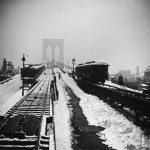 Boston. The New York Stock Exchange was closed for two days…something that almost never happens. Firefighters were unable to get to the fires, and property loss just from the fires was estimated at $25 million. Severe flooding occurred after the storm due to melting snow, especially in the Brooklyn area, which was more susceptible to serious flooding. Efforts were made to push the snow into the Atlantic Ocean. More than 400 people died from the storm and the cold that came with it, including 200 in New York City alone. Among them was former United States Senator Roscoe Conkling. The blizzard also resulted in the founding of the Christman Bird and Wildlife Sanctuary located near Delanson, Schenectady County, New York, which was listed on the National Register of Historic Places in 1970.
Boston. The New York Stock Exchange was closed for two days…something that almost never happens. Firefighters were unable to get to the fires, and property loss just from the fires was estimated at $25 million. Severe flooding occurred after the storm due to melting snow, especially in the Brooklyn area, which was more susceptible to serious flooding. Efforts were made to push the snow into the Atlantic Ocean. More than 400 people died from the storm and the cold that came with it, including 200 in New York City alone. Among them was former United States Senator Roscoe Conkling. The blizzard also resulted in the founding of the Christman Bird and Wildlife Sanctuary located near Delanson, Schenectady County, New York, which was listed on the National Register of Historic Places in 1970.
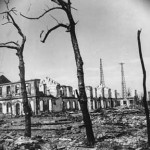 Anytime humans go to war, the one sure outcome is loss of life. That is just a fact of war. Of all the wars that the United States has been involved in, World War II interests me the most, because of my dad’s involvement, I’m sure. War is a brutal activity, but with the evil in the world, it is sometimes necessary. Evil nations leave us no choice but to step in. Such was that case with World War II, and Japan. On this day, March 9, 1945, the United States warplanes launched a new offensive against Japan. The campaign carried out involved dropping 2,000 tons of incendiary bombs on Tokyo over a two day period. Almost 16 square miles in and around the city were incinerated, and between 80,000 and 130,000 Japanese civilians were killed in the worst firestorm in recorded history.
Anytime humans go to war, the one sure outcome is loss of life. That is just a fact of war. Of all the wars that the United States has been involved in, World War II interests me the most, because of my dad’s involvement, I’m sure. War is a brutal activity, but with the evil in the world, it is sometimes necessary. Evil nations leave us no choice but to step in. Such was that case with World War II, and Japan. On this day, March 9, 1945, the United States warplanes launched a new offensive against Japan. The campaign carried out involved dropping 2,000 tons of incendiary bombs on Tokyo over a two day period. Almost 16 square miles in and around the city were incinerated, and between 80,000 and 130,000 Japanese civilians were killed in the worst firestorm in recorded history.
Early that morning, Air Force crews met on the Mariana Islands of Tinian and Saipan for a briefing. This would be a low level bombing attack on Tokyo beginning in the evening, but this one would be different. The planes would be stripped of all guns except for the tail turret. This would decrease the weight…increasing the speed of 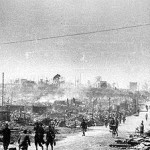 each Superfortress bomber. This also increased the bomb load capacity by 65 percent. Now each plane could carry more than seven tons of bombs. The most crucial thing, however, would be speed. If the plane didn’t make it out of the city, the airmen were warned to get to the water as fast as they could, because their very lives depended on it. Staying in the city would mean a fiery death, because they were going to be delivering the biggest firecracker the Japanese have ever seen.
each Superfortress bomber. This also increased the bomb load capacity by 65 percent. Now each plane could carry more than seven tons of bombs. The most crucial thing, however, would be speed. If the plane didn’t make it out of the city, the airmen were warned to get to the water as fast as they could, because their very lives depended on it. Staying in the city would mean a fiery death, because they were going to be delivering the biggest firecracker the Japanese have ever seen.
The first location would be the suburb of Shitamachi, which was composed of roughly 750,000 people. The destruction of Shitamachi would destroy the light industries, called “shadow factories,” that produced prefabricated war materials for Japanese aircraft factories. The citizens of Shitamachi never had a chance against the Superfortress B-29 bombers. Their fire brigades were undermanned, poorly trained, and ill equipped. All the people could do was to run from the inferno that the city had become. The planes…334 in all, came in a just 500 feet above the ground. Most of them didn’t make it. Doctors said, “The human carnage 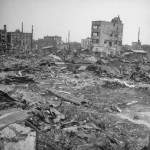 was so great that the blood-red mists and stench of burning flesh that wafted up sickened the bomber pilots, forcing them to grab oxygen masks to keep from vomiting.”
was so great that the blood-red mists and stench of burning flesh that wafted up sickened the bomber pilots, forcing them to grab oxygen masks to keep from vomiting.”
The entire raid lasted just a little longer than three hours. When it was over the Sumida River was clogged with bodies of the dead, burned beyond recognition. The sight was beyond anything anyone could have imagined. The loss of American lives was a mere 243 airmen, and these were considered to be acceptable losses. I suppose that these days, such a raid on known civilian targets would be considered unacceptable, but at the time it was considered acceptable, and even necessary. And it was successful, in a horrible sort of way.
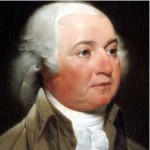 Before women could vote, the first lady in our White House was primarily there to handle the household staff, entertainment, and just look pretty beside her husband…the President. Of course, this was during the age when it was thought that women simply couldn’t handle the serious political information that it took to run a country. These days, women would howl in protest at the thought of being placed in the pretty, but incapable box. In reality, the women back then didn’t like it much either, but it seemed that there was nothing they could do about it…at least, not at the time. Still, even though women were not allowed to vote or have a political voice, there were men who valued the opinions and insights of their wives. One of those men was President John Adams. I suppose that Abigail Adams could have had one of those amazing minds, and that would seem to be the case from the different topics of discussion between John Adams and his wife, but the sequence of events that took place on this day March 7, 1777, is nothing short of amazing.
Before women could vote, the first lady in our White House was primarily there to handle the household staff, entertainment, and just look pretty beside her husband…the President. Of course, this was during the age when it was thought that women simply couldn’t handle the serious political information that it took to run a country. These days, women would howl in protest at the thought of being placed in the pretty, but incapable box. In reality, the women back then didn’t like it much either, but it seemed that there was nothing they could do about it…at least, not at the time. Still, even though women were not allowed to vote or have a political voice, there were men who valued the opinions and insights of their wives. One of those men was President John Adams. I suppose that Abigail Adams could have had one of those amazing minds, and that would seem to be the case from the different topics of discussion between John Adams and his wife, but the sequence of events that took place on this day March 7, 1777, is nothing short of amazing.
While John, who was at the time, a Continental Congressman, was in Philadelphia with the Continental Congress, and Abigail was in Braintree, Massachusetts at the family farm, he wrote her three letters, and received two letters that she had written in February. The correspondence between the two, was quite remarkable, and in all numbered 1,160 letters. They covered topics ranging from politics to military strategy, and from household economy to family health. John could see the value of his wife’s mind in all his life’s work, but probably the most in his presidency…other than family, that is. In many ways, it is sad to think that the minds of so many amazing women have gone untapped when it comes to the political arena. Of course, not all minds, male or female, intelligent or not so intelligent, can be said to have a good grasp of the important things necessary to run a nation, and keep it from derailing…as we have seen in recent years. Our nation needs people who understand how a Constitutional Republic works…and sadly, many don’t. But John Adams knew how important our Constitution was and always would be…as did his wife, Abigail. John was probably on the forefront of modern thought, in that he saw in his wife the ability to think politically, militarily, economically, as well as all of the thoughts any wife and mother has for her family. John and Abigail were not alone either. They were among the few people of that time, who saw women as intellectual and emotional equals.
In his letter, John mentioned that he felt saddened by the move of the capital to Baltimore, saying “This City is a dull Place, in Comparason [sic] of what it was. More than one half the Inhabitants have removed to the Country, as it was their Wisdom to do—the Remainder are chiefly Quakers as dull as Beetles. From these neither good is to be expected nor Evil to be apprehended. They are a kind of neutral Tribe, or the Race of the insipids. By contrast, Adams described the Loyalists, who prepared their Minds and Bodies, Houses and Cellars,  to receive General William Howe should he attack, as a Pack of sordid Scoundrels male and female.” Abigail had written the letters he received on this day, in February, in which she spoke of the difficulty of corresponding during war, but also spoke of the lack of military fervor demonstrated by the New Englanders around her. I’m sure there was a weariness among the people. She wrote that she awaited greater patriotism, greater prosperity and future correspondence from her beloved husband to his devoted Portia, a nickname John had give her likely in reference to the intelligent and devoted heroine of Shakespeare’s Portia in The Merchant of Venice. These words and the respect her husband had for his wife and her mind were very unusual in a time when women were placed in the pretty, but incapable box.
to receive General William Howe should he attack, as a Pack of sordid Scoundrels male and female.” Abigail had written the letters he received on this day, in February, in which she spoke of the difficulty of corresponding during war, but also spoke of the lack of military fervor demonstrated by the New Englanders around her. I’m sure there was a weariness among the people. She wrote that she awaited greater patriotism, greater prosperity and future correspondence from her beloved husband to his devoted Portia, a nickname John had give her likely in reference to the intelligent and devoted heroine of Shakespeare’s Portia in The Merchant of Venice. These words and the respect her husband had for his wife and her mind were very unusual in a time when women were placed in the pretty, but incapable box.

 As people moved West, in search of the wide open spaces, they were leaving the hustle and bustle of the big cities behind…in search of not only a better life, but maybe for the quiet life too. The East was crowded, and loud, and those people who were ready for something different, decided to make the trip out West, where there were still wide open spaces. The funny thing was that they didn’t even have to go all the way to the West coast to be west of where they were. Many families made it as far as what we would call the Midwest, but that was good enough. There was plenty of land to spread out on and it was available. And so the country began to grow. It really was inevitable anyway, whether it happened then or later. As people grow up and have families, the population grows. It just doesn’t take long to overpopulate a small area. There are few options left, the best one being for some people to move away.
As people moved West, in search of the wide open spaces, they were leaving the hustle and bustle of the big cities behind…in search of not only a better life, but maybe for the quiet life too. The East was crowded, and loud, and those people who were ready for something different, decided to make the trip out West, where there were still wide open spaces. The funny thing was that they didn’t even have to go all the way to the West coast to be west of where they were. Many families made it as far as what we would call the Midwest, but that was good enough. There was plenty of land to spread out on and it was available. And so the country began to grow. It really was inevitable anyway, whether it happened then or later. As people grow up and have families, the population grows. It just doesn’t take long to overpopulate a small area. There are few options left, the best one being for some people to move away.
I understand how they feel. While I have had my time living in the country, and I would not go back again, I am also drawn to the wide open spaces…or at least the long trails. It is such a great feeling to be able get away from it all, and just listen to the quiet for a while. Of course, the quiet is never totally quiet, but rather is has many sounds in it, like the birds chirping, the breeze blowing, bugs making their sounds, or a creek bubbling along. Nevertheless, quiet or not, it’s different, and that makes it the kind of peaceful sounds you need. And for 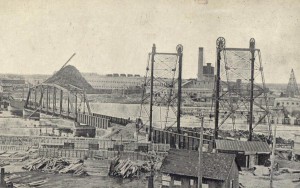
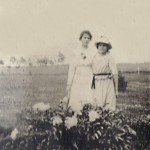 me, a few days hiking on a long trail through the mountains and forests, is just what I need to renew my sense of balance and peace. Does that mean that I would love to have been one of the pioneers who went out West to find a better life…no, I don’t think so. Life was hard for the pioneers. In reality, they paid dearly for the quiet life. There were no stores, or at least, not many. Water was scarce. They have to grow food. They worked hard…from morning to night. Yes, it was the quiet life, but it wasn’t easy…and that’s for sure.
me, a few days hiking on a long trail through the mountains and forests, is just what I need to renew my sense of balance and peace. Does that mean that I would love to have been one of the pioneers who went out West to find a better life…no, I don’t think so. Life was hard for the pioneers. In reality, they paid dearly for the quiet life. There were no stores, or at least, not many. Water was scarce. They have to grow food. They worked hard…from morning to night. Yes, it was the quiet life, but it wasn’t easy…and that’s for sure.
 I have always been one to read the obituaries in the paper. Sometimes, I find that the deceased is someone I know, or that their family is someone that I know. I suppose many people might think it odd that I read the obituaries, but in searching my family tree, I find that they can be a wealth of information into the life of that person. I have been able to clarify children’s names, parents names, and siblings names, just by looking at the obituaries of my ancestors. I have also found out for sure, who their parents and even grandparents were by reading their obituaries. Things like place of birth, and early childhood years and locations are listed there, as well as, careers, hobbies, club memberships, and homestead information, along with place of birth and death, and even burial. It is clearly a wealth of information that, to the genealogist, is pure gold, because so often, information was not well kept. Names were left off, dates, and even who the person was related to. It makes it very difficult to search.
I have always been one to read the obituaries in the paper. Sometimes, I find that the deceased is someone I know, or that their family is someone that I know. I suppose many people might think it odd that I read the obituaries, but in searching my family tree, I find that they can be a wealth of information into the life of that person. I have been able to clarify children’s names, parents names, and siblings names, just by looking at the obituaries of my ancestors. I have also found out for sure, who their parents and even grandparents were by reading their obituaries. Things like place of birth, and early childhood years and locations are listed there, as well as, careers, hobbies, club memberships, and homestead information, along with place of birth and death, and even burial. It is clearly a wealth of information that, to the genealogist, is pure gold, because so often, information was not well kept. Names were left off, dates, and even who the person was related to. It makes it very difficult to search.
In the case of my 2nd great aunt, Theresa “Tessie” Elizabeth Spencer Davis, I found a wealth of information in her obituary, when I came across it in my Uncle Bill Spencer’s family history information. She was born, the 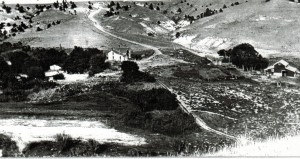 seventh child of my 3rd great grandparents, Allen and Lydia Spencer, on October 8, 1864, in Brooklyn, Iowa. Her parents had a family of nine children in total. She married William Jonathan Davis on September 29, 1883, in Webster City, Iowa, and in 1888, She and her family became pioneers, when they moved out west to Nebraska. They first moved to Crookston, later to For Robinson, and in 1892, the homesteaded in Pine Creek, where they lived until their retirement, at which time they moved into Rushville, having given the homestead to their children. William preceded Tessie in death in 1925…so many losses to endure.
seventh child of my 3rd great grandparents, Allen and Lydia Spencer, on October 8, 1864, in Brooklyn, Iowa. Her parents had a family of nine children in total. She married William Jonathan Davis on September 29, 1883, in Webster City, Iowa, and in 1888, She and her family became pioneers, when they moved out west to Nebraska. They first moved to Crookston, later to For Robinson, and in 1892, the homesteaded in Pine Creek, where they lived until their retirement, at which time they moved into Rushville, having given the homestead to their children. William preceded Tessie in death in 1925…so many losses to endure.
Life was never easy for Tessie. she lost siblings, as well as, seven of her eleven children before her own death…many of them young. She was the last of her siblings to pass away, and she outlived her husband by almost twenty years. The obituaries of the past listed even more information. Tessie was Methodist, and she belonged to the American Legion Auxiliary. She also belonged to a group called Royal Neighbors…she was a 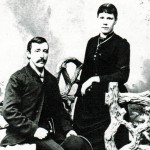 charter member. And she was a Gold Star Mother, but I’m not sure what that was for sure. The thing that stuck out for me the most, however, was that Tessie was a pioneer. The writer of the obituary said that, “In her passing, another pioneer has gone to the great beyond having courageously and triumphantly overcome the hardships, privations, and trials of the early settler that has made it possible for this generation to live the more modern life such as was not known to the pioneer. She was generous and hospitable, never thinking of herself, but often going out of her way to help a friend.” With everything that I learned about my 2nd great aunt, those words were by far the most amazing. They told of who she really was…deep inside. And Tessie Spencer Davis was simply an amazing woman.
charter member. And she was a Gold Star Mother, but I’m not sure what that was for sure. The thing that stuck out for me the most, however, was that Tessie was a pioneer. The writer of the obituary said that, “In her passing, another pioneer has gone to the great beyond having courageously and triumphantly overcome the hardships, privations, and trials of the early settler that has made it possible for this generation to live the more modern life such as was not known to the pioneer. She was generous and hospitable, never thinking of herself, but often going out of her way to help a friend.” With everything that I learned about my 2nd great aunt, those words were by far the most amazing. They told of who she really was…deep inside. And Tessie Spencer Davis was simply an amazing woman.
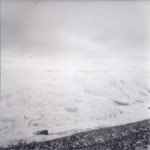 It happens every year, although maybe not to this degree, but when it has been a long cold winter, the ice can get really thick on Lake Superior, and when it begins to thaw, ice can make its way onto the shoreline because of the movement of the deep water. I saw a video a few days ago that showed Lake Superior thawing and the ice shards coming ashore. They weren’t thick, because this Winter, while bad enough back there, was not as bad as the one we had in 1958, when I was almost two years old. That year, the ice was so thick, that it came ashore as very large ice slabs. When the ice comes into the shore on Lake Superior, it can overflow onto streets and yards near the shore.
It happens every year, although maybe not to this degree, but when it has been a long cold winter, the ice can get really thick on Lake Superior, and when it begins to thaw, ice can make its way onto the shoreline because of the movement of the deep water. I saw a video a few days ago that showed Lake Superior thawing and the ice shards coming ashore. They weren’t thick, because this Winter, while bad enough back there, was not as bad as the one we had in 1958, when I was almost two years old. That year, the ice was so thick, that it came ashore as very large ice slabs. When the ice comes into the shore on Lake Superior, it can overflow onto streets and yards near the shore.
I can’t say that I recall the time we spent on the ice slabs that year, but apparently the 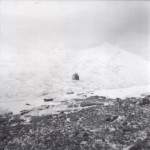 ice slabs, shards, or just ice in general are things that the people along Lake Superior celebrate. I suppose when Winter is a longer lasting season, finding a way to have fun in it is essential. Enter the Ice Festival. From what I can see, and I hope some of my Duluth/Superior family members will fill me in, there are a number of events. On the website, I saw ice sculptures, ice princesses, bon fires and s’mores, warming houses with hot drinks to warm up with, food, fireworks, children’s story time, and crafts, so there is truly something for everyone, and it’s all about having fun.
ice slabs, shards, or just ice in general are things that the people along Lake Superior celebrate. I suppose when Winter is a longer lasting season, finding a way to have fun in it is essential. Enter the Ice Festival. From what I can see, and I hope some of my Duluth/Superior family members will fill me in, there are a number of events. On the website, I saw ice sculptures, ice princesses, bon fires and s’mores, warming houses with hot drinks to warm up with, food, fireworks, children’s story time, and crafts, so there is truly something for everyone, and it’s all about having fun.
I don’t know if we were at an Ice Festival when my parents took us out to see the ice slabs on Lake Superior’s shores, but in looking at the pictures, I must say that they were definitely impressive. I know that the ice festival is not as much about the ice 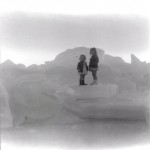 slabs around the lake, but rather about the fact that, at this point, most people are really over Winter by now. Finding fun things to do that are associated with ice, as well as the coming Spring, is a way to lift everyone’s spirits. I can tell from the pictures my parents took at the time, that they and we were impressed with ice slabs that had come on shore that year. I think anyone would have been impressed, because they were huge that year. Some of them were half my height, not that I was tall, but that really is pretty thick. I’m sure it was somewhat cold out there, and back then, little girls wore dresses a lot of the time, but my sister, Cheryl Masterson, and I did not seem to mind the cold. I guess it was the wonder of it all. Maybe that is why they have an Ice Festival..so people can embrace the ice…so to speak.
slabs around the lake, but rather about the fact that, at this point, most people are really over Winter by now. Finding fun things to do that are associated with ice, as well as the coming Spring, is a way to lift everyone’s spirits. I can tell from the pictures my parents took at the time, that they and we were impressed with ice slabs that had come on shore that year. I think anyone would have been impressed, because they were huge that year. Some of them were half my height, not that I was tall, but that really is pretty thick. I’m sure it was somewhat cold out there, and back then, little girls wore dresses a lot of the time, but my sister, Cheryl Masterson, and I did not seem to mind the cold. I guess it was the wonder of it all. Maybe that is why they have an Ice Festival..so people can embrace the ice…so to speak.
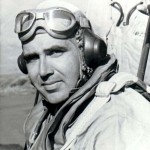
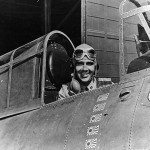 It takes many different kinds of soldiers, foot soldiers, seamen, and airmen, to win a war. One group supports the others, and without all of them, winning a war in modern times would be next to impossible. Partly because my dad fought in World War II, I find myself most interested in that war. I am very proud of the part my dad played in shooting down enemy aircraft from his position as top turret gunner, and along with his crewmembers, providing air support for ground missions. Of course, many of the heroes who are remembered in a war, are the men in the little fighter planes. The fighting they do is very dramatic, and watching movies or documentaries about the planes they shoot down is exciting. We know of the dangers they face every time they take off, and that adds to the amazement when they are successful.
It takes many different kinds of soldiers, foot soldiers, seamen, and airmen, to win a war. One group supports the others, and without all of them, winning a war in modern times would be next to impossible. Partly because my dad fought in World War II, I find myself most interested in that war. I am very proud of the part my dad played in shooting down enemy aircraft from his position as top turret gunner, and along with his crewmembers, providing air support for ground missions. Of course, many of the heroes who are remembered in a war, are the men in the little fighter planes. The fighting they do is very dramatic, and watching movies or documentaries about the planes they shoot down is exciting. We know of the dangers they face every time they take off, and that adds to the amazement when they are successful.
During World War II, to acquire Ace status, a fighter had to shoot down five enemy planes. On February 20, 1942, the United States received it’s first Flying Ace of World War II. His name was Lieutenant Edward O’Hare. O’Hare was a US Navy fighter pilot with the Fighting Squadron 3, aboard the USS Lexington. The Lexington, sailed into the Coral Sea in mid-February, 1942. Then on February 20th, as the Lexington neared Rabaul, Japanese radar picked up the ship. Japanese bombers headed straight for it. O’Hare and his team went into action. They were piloting F4F Wildcats. In just four minutes, O’Hare shot down five Japanese G4M1 Betty bombers. This ended the Japanese attack and O’Hare became an Ace. It also ended the planned raid, because the element of surprise was gone. O’Hare was awarded the first naval Medal of Honor awarded in World War II. He was a great shot, but on November 26, 1943, his luck ran out. His plane was shot down during a nighttime fighter attack near the Gilbert Islands. It was never found. In 1945, the Navy named a destroyer the USS O’Hare after him. Later, Chicago’s Orchard Depot Airport was renamed, O’Hare international Airport after him.
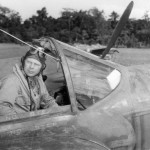
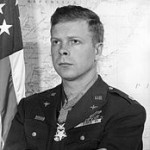
O’Hare was the first ace of World War II, but he was not the Ace with the most kills in World War II…that honor belongs to a man born in the same town I was…Superior, Wisconsin. Richard Bong shot down 40 enemy aircraft before he was killed on August 6, 1945 over North Hollywood, California, while testing a P-80A jet. The plane exploded causing Major Bong’s death. The flying aces of World War II were many…too many to name here, but among the notables are Edward O’Hare, Richard Bong, and Chuck Yeager. All the aces were heroes.
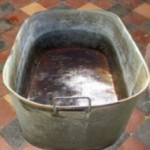
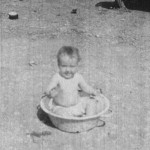 In the days before running water in homes, people had to go to river to bath, or bring water into the house from the river, creek, or well, and heat it on the stove so the family could bathe. Since families were usually large, the whole process took time, and heating water over and over again was not really feasible. What that meant was that the family pretty much all bathed in the same bath water. For the last guy, that had to be…well, disgusting, but that was the way it was done back in the old west, and even in more recent times when there was no running water in homes. For the little kids, however, I seriously doubt if it mattered. Getting wet was getting wet, and it really just didn’t matter what the water looked like…at least to the little boys. Girls might have felt differently. I think I would have.
In the days before running water in homes, people had to go to river to bath, or bring water into the house from the river, creek, or well, and heat it on the stove so the family could bathe. Since families were usually large, the whole process took time, and heating water over and over again was not really feasible. What that meant was that the family pretty much all bathed in the same bath water. For the last guy, that had to be…well, disgusting, but that was the way it was done back in the old west, and even in more recent times when there was no running water in homes. For the little kids, however, I seriously doubt if it mattered. Getting wet was getting wet, and it really just didn’t matter what the water looked like…at least to the little boys. Girls might have felt differently. I think I would have.
Personally, if I had a river or creek available, I think I would use that…in the summer anyway. Then again, there is very little privacy in a river or creek…and you can’t exactly put up a curtain around a river. I can’t really imagine how they lived that way exactly. I guess in that way I’m a modern girl, and don’t try to take my shower away from me. Maybe that’s why Bob and I don’t go camping…no running water, or if there is, it’s very inconvenient. As I have said before, I love hiking and being outdoors, but I like the modern conveniences of a hotel room afterward.
Of course, when homes got running water, bathing in an old tin bath tub went the way of all things old west. Nevertheless, for babies…it doesn’t matter if they are bathing or just playing in a bucket, pan, or clothes 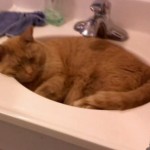
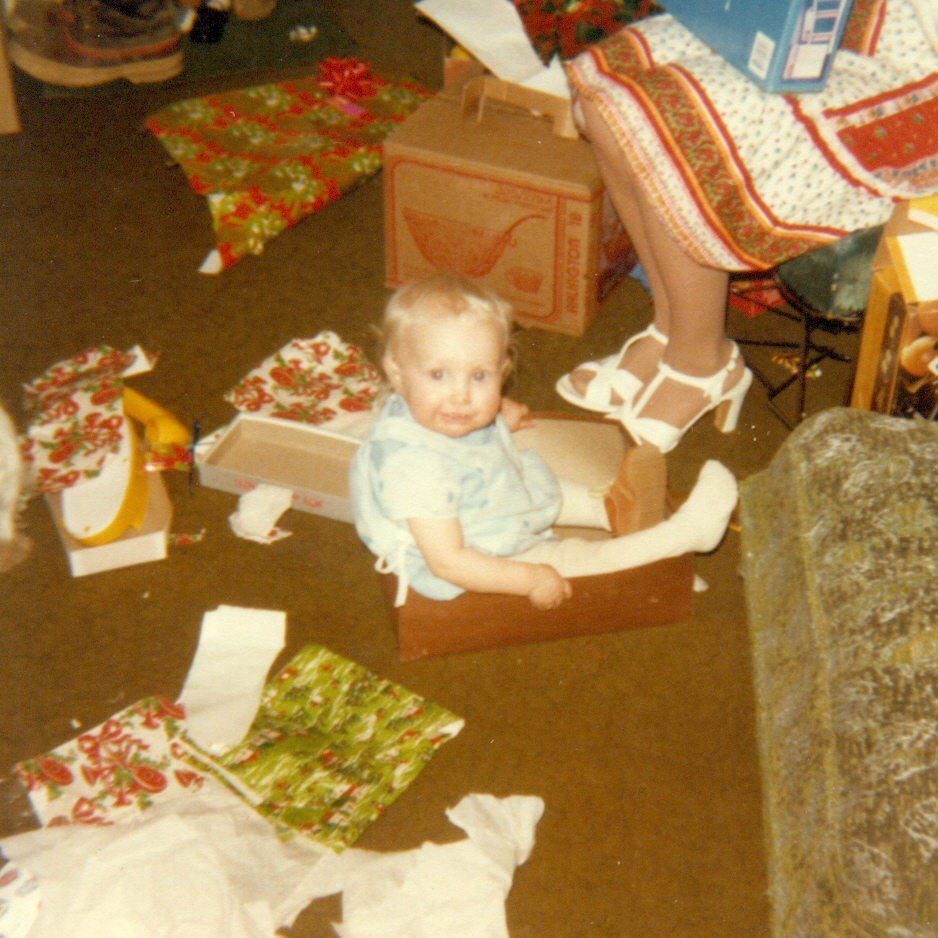 basket. Kids just like to play in them. I don’t think there is anything so amazing about that, like a throwback to the old west days of bathing in a barrel, but rather that kids just like finding different places to play. Things like an old box, barrel, or clothes basket are perfect. In that way, they remind me of cats. If you have ever watched a cat, you will find that they see a space, and if it looks fairly close to a good fit, in they dive. Babies tend to be that way too…but, the thing that is the funniest about that is when the baby tries to fit into a box that is seriously too small. Nevertheless, it’s a baby or cat thing.
basket. Kids just like to play in them. I don’t think there is anything so amazing about that, like a throwback to the old west days of bathing in a barrel, but rather that kids just like finding different places to play. Things like an old box, barrel, or clothes basket are perfect. In that way, they remind me of cats. If you have ever watched a cat, you will find that they see a space, and if it looks fairly close to a good fit, in they dive. Babies tend to be that way too…but, the thing that is the funniest about that is when the baby tries to fit into a box that is seriously too small. Nevertheless, it’s a baby or cat thing.
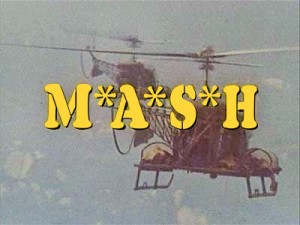 For years many Americans, myself included, were drawn into the Korean War, or at least one aspect of it, in the form of M*A*S*H, a popular television show about the way a Mobile Army Surgical Hospital was run…sort of. The show took on more than just the hospital side, by including a comical side that portrayed the antics of Benjamin Franklin Pierce, aka Hawkeye, and his best friend and co-conspirator, BJ Honeycutt. I can’t say just how true to life the show was, but we all cried right along with the doctors and nurses when they lost a patient, and cheered when they saved one.
For years many Americans, myself included, were drawn into the Korean War, or at least one aspect of it, in the form of M*A*S*H, a popular television show about the way a Mobile Army Surgical Hospital was run…sort of. The show took on more than just the hospital side, by including a comical side that portrayed the antics of Benjamin Franklin Pierce, aka Hawkeye, and his best friend and co-conspirator, BJ Honeycutt. I can’t say just how true to life the show was, but we all cried right along with the doctors and nurses when they lost a patient, and cheered when they saved one.
In reality, the MASH units were a vital part of the war effort, and the saving of  the lives of many soldiers. These were amazing surgeons who learned techniques that cut corners, making surgeries faster and more efficient, bringing lifesaving changes to medicine in the process. The MASH units were originally established in August of 1945, and then were deployed during the Korean War and later conflicts. The Army deactivated the last MASH unit on February 16, 2006, which I did not know, but I’m sure most of my military friends probably did. The MASH units were replaced by the CSH or Combat Support Hospital. I’m sure the CSH units are amazing units too, and maybe someday they will have as big a place in history as the MASH units did, but unless they do a television show that is as popular as the M*A*S*H show was, I don’t think their place in history will be as well known to the American people as the MASH units were. I’m sure that with all the improvements, the CHS units are probably better and more up to date than the MASH units were, but in the hearts of the M*A*S*H fans, the CHS units have big shoes to fill.
the lives of many soldiers. These were amazing surgeons who learned techniques that cut corners, making surgeries faster and more efficient, bringing lifesaving changes to medicine in the process. The MASH units were originally established in August of 1945, and then were deployed during the Korean War and later conflicts. The Army deactivated the last MASH unit on February 16, 2006, which I did not know, but I’m sure most of my military friends probably did. The MASH units were replaced by the CSH or Combat Support Hospital. I’m sure the CSH units are amazing units too, and maybe someday they will have as big a place in history as the MASH units did, but unless they do a television show that is as popular as the M*A*S*H show was, I don’t think their place in history will be as well known to the American people as the MASH units were. I’m sure that with all the improvements, the CHS units are probably better and more up to date than the MASH units were, but in the hearts of the M*A*S*H fans, the CHS units have big shoes to fill.
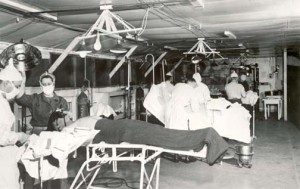 Many an evening has found Bob and I watching a M*A*S*H marathon. And during the original years, we watched it every night that it was on. We simply liked the show. I have to wonder if any other war has been watched as much as the Korean War…even though people didn’t necessarily realize that they were watching a war, or at least a part of it. While we may not have really learned a lot about the Korean War from this source, we did learn something about one part of the war…a vital part in all reality. Now that M*A*S*H is on again as re-runs, we often fine ourselves watching it again…even though we know how it will end. It is just one of those timeless shows. You just really never get tired of them…even the re-runs.
Many an evening has found Bob and I watching a M*A*S*H marathon. And during the original years, we watched it every night that it was on. We simply liked the show. I have to wonder if any other war has been watched as much as the Korean War…even though people didn’t necessarily realize that they were watching a war, or at least a part of it. While we may not have really learned a lot about the Korean War from this source, we did learn something about one part of the war…a vital part in all reality. Now that M*A*S*H is on again as re-runs, we often fine ourselves watching it again…even though we know how it will end. It is just one of those timeless shows. You just really never get tired of them…even the re-runs.

